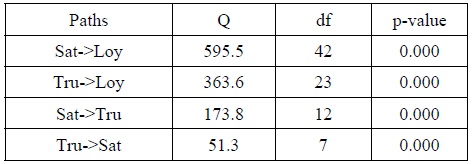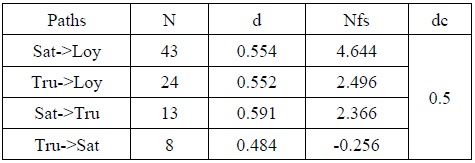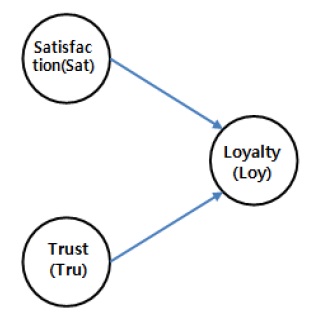



메타분석은 여러 실증연구의 정량적인 결과를 통합과 분석을 통해 전체 결과를 조망할 기회를 제공하는 통계적 통합 방법이다. 전자상거래 연구에서 만족, 신뢰와 충성도 간의 관계에 관한 연구들을 문헌연구와 메타분석을 실시하였다. 최근 전자상거래나 정보통신기술과 지식정보사회의 융합은 정치, 경제 및 다양한 분야에 빠른 영향을 미치고 있다. 본 연구는 2002년부터 2013년까지 우리나라 학술지에 게재된 연구 중 만족, 신뢰 및 충성도의 인과관계가 설정된총 57편의 연구논문을 대상으로 하였다. 메타분석의 결과 만족과 신뢰의 경로가 가장 큰 효과 크기로 나타났으며, 효과 크기는(r = .591)이었다. 두 번째 효과 크기는 만족과 충성도 경로에서 효과 (r = .554), 다음으로 신뢰와 충성도 경로에서는(r = .552)로 나타났다. 그런데 신뢰와 만족 경로에서는 가장 낮은 효과 크기(r = .484)로 나타났다.
Recently, advances in multimedia broadcasting communications have introduced a variety of platform technologies that offer related application services. The convergence of knowledge-based society and information telecommunication technologies has a rapid impact on politics, economics and various fields. The development of information technology and information telecommunication technology, drive the rapid expansion of behavioral intention in e-commerce. The rapid growth of e-commerce market is ascribed to the super highway internet and network infrastructure, a seemingly endless increase of internet users. The expansion of online shopping malls provides companies with the opportunity of an expansion of circulation and an improvement of communication with customers. The companies envision cost reductions for the company and a concurrent improvement in customer service. E-commerce market is predicted to reach USD 1 trillion in 2014. The Internet shopping, as well as competition across industries and, in the industry has intensified. In this competitive e-commerce environment, improving customer loyalty is emphasized as the most important success factor to retain existing customers for the company.
In previous research of the business organization literature, trust focuses on the trust mechanism as an alternative mechanism of hierarchy and pricing mechanism. In the marketing literature, trust has been examined as a variable to maintain the business relationship in a long-term dealing a distribution channel. Customer loyalty is a variable, commonly categorized as brand loyalty, service loyalty, and store loyalty, etc. When compared to traditional markets, the customer loyalty in the Internet market acted as competitiveness advantage for the company. Today, market entry of competitors in the Internet environment is relatively easy, than in the traditional off-line market. In addition, the very low switching cost due to the nature of the Internet makes customers easily to leave for other companies’ websites to look for better deals. The loyalty of customers could be the core value of business in Internet shopping to retain existing customers and ultimately increase sales [1]. The research model is depicted in Fig. 1 proposes the relationships among satisfaction, trust, and loyalty in e-commerce in this study.
As it is proposed in the research model, customer satisfaction and customer trust have a reciprocate relationship. Furthermore, customer satisfaction and trust increase customer loyalty, an ongoing relationship in a long-term [2]. The study on “An Analysis of Variables Affecting Customer Loyalty in Internet Banking” [3] supported that the correlation of the path from the satisfaction to the loyalty showed the effect size (r =. 54). In addition, the results of the study showed that the correlation of the path from the trust to the loyalty was the effect size (r =. 22), and the correlation of the path from the trust to the satisfaction showed the effect size (r =. 29). In the study on“The Structural Relationship among Influential Factors, Satisfaction and Customer Loyalty on Internet Shopping” [4], the correlation of the path from the satisfaction to the trust showed the effect size (r =. 46). It implies that customer trust is continuous and a decisive factor of customer satisfaction, meaning the extent to which product/service/store fulfills the customer's request [1].
A meta-analysis refers to a statistical literature synthesis method from the quantitative results of many known empirical studies [5]. The meta-analysis can be described as expressed analysis. The methodological approaches and characteristics of meta-analysis are as follow. In terms of quantity, a meta-analysis is to use the summary statistics to integrate the data simply. In addition, the effect size is calculated by using different research methods and results to measure. As it can be compared with the integration, the effect size is converted to a common unit. Thus, a meta-analysis can be derived conclusion commonly. In addition, a small difference between studies can be neglected for generalization even when different effect sizes are used [6]. This study reviewed research papers that examined causal relationships among satisfaction, trust, and loyalty in e-commerce. The research papers were published in Korea academic journals on e-commerce research during 2002 and 2013. The papers included in this study meta-analysis were identified using keywords that are “e-commerce loyalty”, “e-commerce satisfaction” and “e-commerce trust", specifying on RISS, DBpia, KISS in database articles of social science. A total of 234 research papers were found, consisting of 200 papers from RISS, 23 papers from DBpia and 11 papers from KISS through the search. This study filtered research papers published in Korean academic journals with the study criteria and then targeted a total of 57 papers for this study purpose. Based on the methodology of meta-analysis, was utilized the CMA (comprehensive meta analysis) program developed by Biostat was utilized.
The homogeneity test in the meta-analysis was performed on these research subjects to find that the effect sizes of multiple independent studies are values extracted from the individual population. Statistical null hypothesis for the homogeneity test, showed that no difference between the estimates of the effect size of the results of the individual studies. When the null hypothesis is accepted, a meta-analysis can be performed to obtain an estimate of the comprehensive effect size by integrating the estimated effect sizes. For interpretation of homogeneity test, the Q values of the test statistics based on chi-square distribution isused. The Q values are the same with the chi-square distribution. The results of heterogeneity test are shown in Table 1.
[Table. 1] Results of homogeneity test

Results of homogeneity test
Q-values in paths Sat->Loy, Tru->Loy, Sat->Tru and Tru->Sat is 595.5, 363.6, 173.8, 51.3, if and p = 0.5, chi-squared critical value were 55.75, 35.17, 21.03, 14.07 respectively. Therefore, the Q values were bigger than the limit value, the null hypothesis of homogeneity were rejected. Because it was not extracted from the same population, it could establish estimation as consisting of heterogeneous data set. In other words, the sizes of effects for all paths are regarded as being over the standard error. In this heterogeneous case, we calculate the average effect size by using calibrated inverse variance weighting values with the random-effects model, not the fixed-effects model [7,8]. In summarizing the results of previous studies in the specific field, a matter of publication bias or the file drawer problem can be occurred when the normalization of the sample does not include all of the previous studies in the field, but it only represents part of previous studies. This implies that papers published in journals have a high likelihood of positive results as compared to unpublished papers. The result of calculating Fail-safe number is shown in Table 2.
[Table. 2] Results of calculator for fail-safe number

Results of calculator for fail-safe number
This study reanalyzed the research papers with the purpose to classify the results of the previous studies that causal relationships among satisfaction, trust and loyalty in the e-commerce research, published Korean academic journals during 2002 and 2013. A total of 57 research papers were filtered with the study criteria from three databases and examined the causal relationships among satisfaction, trust, and loyalty in e-commerce the proposed research model of this study As shown in the collected data set (see APPENDIX), the values of effect size using the inverse weighted-mean as method approach with the random effect model are provided for the paths from Sat to Loy, from Tru to Loy, from Sat to Tru and from Tru to Sat. First, the result of the meta-suggests that the highest effect size is the path from the satisfaction to the trust (the effect size 0.591). The effect size for the path from the satisfaction to the loyalty showed similar and slightly higher with the effect size in the research of Kim and Oh [4]. Second, the effect size for the path from the satisfaction to the loyalty showed similar to the effect size in the research of Kang and Lee [3]. Next, the effect size for the path from the trust to the loyalty showed very higher than the effect size in the research of Kang and Lee [3]. Also, the effect size for the path from the trust to the satisfaction showed much higher than the effect size in the research of Kang and Lee [3]. In summarize, the result of the meta-analysis can be concluded that lower effect size (r = .484) for the path from the trust to the satisfaction. The three factors in the proposed research model have a power of explanation about 50% or more. Further, the predictive variables of this study have power of explanation about 50% or more. In conclusion, the result of the study is significant in that we can estimate effect sizes on the basis of path constructs. In addition, we expect that the results of by this study would be touchstones to researchers in similar studies.


